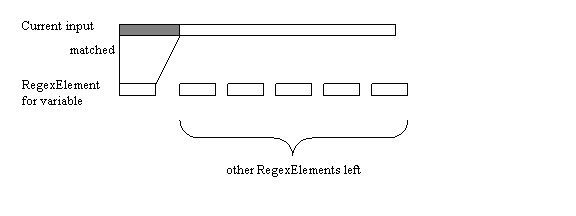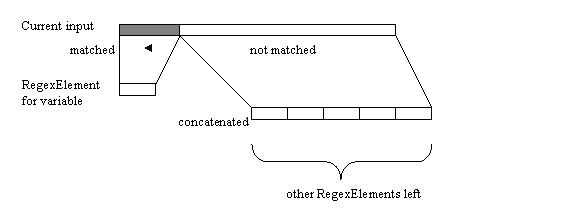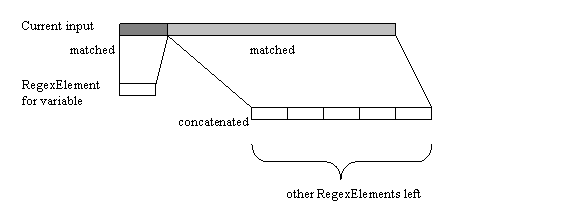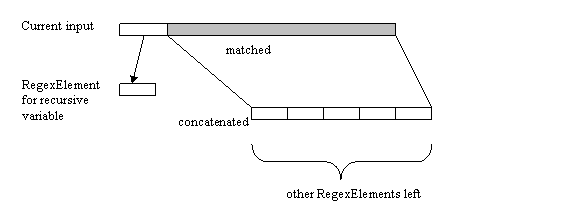tauZaman
DESIGN DECISIONS (Parsing, deprecated)
Parsing consists of two components in the system. One of them is input parsing,
which takes a temporal constant and parses it into a timestamp. The other one is
output parsing, which takes a timestamp and parses it into temporal constant.
However, in this context, we'll not talk about the whole process of forming a
timestamp given a temporal constant or vice versa. We'll try to focus on the
question of, "how can we parse (or fetch) related information from an input?".
For
input parsing, we are given a temporal constant and a format, which we have to
apply format to temporal constant and get useful information, field values, if
possible. For output parsing, we are given a timestamp and again a format, which
we have to fetch useful information from timestamp and apply format to these
useful information to get a formatted temporal constant. Let's see each of the
processes separately.
Input Parsing
Givens: String input, Format
format
Output: Fields consists of
Fields (basically a
Field contains a "useful string"
fetched from input)
To make it clear, let's see some examples;
Example 1
input = "January
01, 1970"
format = { "$month
$day, $year" , not whitespace friendly}
output = { {month,
"January"}, {day, "01"}, {year, "1970"} }
Example 2
input = "<date day = "
12" month = 'Pre September' year = " 2003 " />"
format = { "< date year
= "$year " day = "$day" month = "$month" />" , whitespace friendly}
output = { {day, "01"},
{month, "Pre September"}, {year, "2003"} }
Example 3
input = "<period>
<instant day = "01" month = "September" year = "2002" />
<instant>
<day> 12 </day>
<month value = 'October' />
<year value = "2003" />
</instant>
</period>"
format = { "<period>
<instant day = "$day " month = "$month" year = "$year" />
<instant>
$instantEnd
</instant>
</period>" , whitespace friendly}
format for instantEnd =
{"
<day> $day </day>
<month value = '$month' />
<year value = "$year" />
", whitespace friendly}
at the end of, so
called, recursive evaluation;
output = { {day, "01"},
{month, "September"}, {year, "2002"}, {day, "12"}, {month, "October"},
{year, "2003"}}
All
these examples explain the goal very nicely, however, implementation is a
little bit difficult then it seems at first. Let's see the design alternatives
and final decisions.
Design Alternative 1
We are processing XML fragments (givens; input and format), so, it is natural to
parse them into DOM objects and traverse both in order, getting the "useful
values" when acrossing each corresponding node pairs. There are two problems with this approach; First
problem is that, this approach involves in DOM parsing for both of the givens.
Even if we cache parsed version of format for future uses, we still have to
store them as DOM, which takes more space then a string representation (such as
regular expressions, as we will explain it in a minute). And
also, each time we have an input (even again we have a cached parsed format), we
have to parse input into a DOM. For excessive number of inputs that can reduce
the performance.
Second problem is more related to implementation view. The problem comes from
our system's ability to represent extensive kinds of inputs. Let's see one example;
format: {"<period>
$instantStart
/
$instantEnd
</period>",
whitespace friendly}
input 1: "<period>
01
< month value = "September"/>
2003 / 02
< month value = "October"/>
2004
</period>"
input 2: "<period>
01/04/2002 / 2, October 2004
</period>"
input 3: "<period>
<instant>
01 12 1999
</instant>
/
<instant>
02 12 1999
</instant>
</period>"
The difficulty is that format should get the right pieces into the right
recursive variables, instantStart and instantEnd, for further processing. However, since structure of xml
could be complex, it is very hard process to have a correct state after we parse
it. To implement this, most likely, we have to have iterators, but since they
can not foresee the items, there will be lots of stops and restarts.
For example, when we traverse the format above, we see that we have get value of $instantStart
from input. But when we are fetching text nodes, elements, attributes from input
to satisfy this, where should we stop? We know that in format $instantStart ends
with a '/'. So, we may use it to stop fetching process in input. But this is
hard to do with DOM structure. For example in input 1, we find '/' at the middle
of a text node, and we have to divide it in order to fetch it.
Design Alternative 2
We may first produce a list of regular expressions, which is equivalent to given
format. And we can fetch the "useful values" by parsing inputs with these
regular expressions. This approach inherently contains some disadvantages and
advantages. Main disadvantage is, we have to enforce some DOM (XML) related
characteristics on regular expressions. For example; we can not have attribute
order independency without using a trick on produced regular expressions.
Another example would be, forming regular expression such that we will be able
to represent
both kinds of empty elements (<foo/> and <foo></foo>). For XML there will
be no difference between them, however, since we parse inputs as character based, we
have to be prepared for that. And also there is no difference between <foo> and
<foo >, but if we apply a not whitespace friendly format, although it applies
only to text nodes and attribute values since we parse input as characters we
have to ignore this for elements. All these make forming of regular expression a little
tedious.
Advantages of this approach are, we can process resume and restart with regular
expressions using java built in package. That surely makes implementation more
reliable. Also, another important advantage is, once we formed regular
expression bag for a format, then we may cache it, and use for future inputs. As
we will point that later in test runs, this reduces parsing time sharply.
Before going through the details, let's see the trick that is used for enforcing
attribute order independency. Attribute order independency can be handled in two
ways. First way is to change input's attributes' order as format has it. But
this brings additional over head, for each input we have to perform XML to DOM
and then again DOM to XML transformation, moreover, depending on the
transformation we use, attribute order may still change (unless we write our own
DOM to XML program), also when we cache the parsed format, we have to keep some
additional information about order of attributes. Second way consists of a trick
which is, when we come across with attributes of an element we will form a
regular expression that says (attr_name1 | attr_name2 |
attr_name3 | ...). And since attribute names are unique in a single element,
this works. However, for attribute values, we have to keep them as separate,
since in input we never now which attribute name comes in which order, and
having (attr_name1 = "regex for attr1" | attr_name2 =
"regex for attr2"| attr_name3 = "regex for attr3" |
...) does not work, since fetching values for variables depend on concatenating
regular expressions that are not processed yet. So, for these reasons attribute
values are kept separately from all other regular expressions.
We
chose the second design alternative. And here are the details;
2
Stage Input Parsing
As stated in alternative 2 briefly, there are two stages for input parsing.
In the first stage, we parse format and produce a list of regular expressions.
Before going that let's state some facts about format.
-
variable names in a
format starts with '$' and ends with either with another variable, which again
starts with '$' or a whitespace. Ex: "$month$year", here we have two
variables, called month and year. "$month $year" here we have the same
situation.
-
'\' is the escape
character for itself and '$' only. Ex: "\\" corresponds to "\" and "\$"
corresponds to character "$".
-
Element and attribute
names are assumed to include characters ([{\^$|)?*+. These are also special
characters in java.util.regex package, so, we have to escape all attribute and
element names. But main rules for element names in xml are;
-
name can contain
letters, numbers, other characters
-
must not start with a
number or a punctuation character.
So, how do we produce a
list of regular expression from a format? Basically for elements and attributes
regular expressions are formed containing their names. Only in text nodes and
attribute values, we may include variables, so, we have a special parsing for
them. They are parsed character by character until a "$" sign, which is a
variable and handled in a different way. All the regular expressions in the list
are formed in order, however, regular expressions for attribute values in an
element, are not formed in an order to enforce order independency.
Each regular expression
is kept in an object, which is an instance of RegexElement class. This class, in
addition to string regular expressions, keeps supplementary information about
them. For example, type. A regular expression may correspond to a variable or a
variable attribute or a recursive variable (recursive variables are the ones
that need further processing, such as instants).
As one can note, the end
product of this stage is independent to any input. Additionally, it takes time
to process it each time we come across with an input. So, it will reduce respond
time if we can cache this list instead of format itself.
In the second stage,
after list of RegexElements are formed from a format, we apply them in order to
an input according to different types. For example, if a RegexElement is of type
variable, then it should be taken care of differently than if it is of type
normal. The important questions are, how do we fetch the value of a variable and
value of a recursive variable from the input? Let's see these with a
visualizations. First fetching a variable;
Assume we are at the
middle of parsing an input, and we have current input, and regular expressions
that are left.

First apply regular
expression for this variable

If there is no match,
then parsing failed. If there is a match, since the java.util.regex runs on
maximum matching semantic, we might over matched. So, to understand it, we
concatenate all other regexes (regular expressions) together and apply to the
rest of the input.

If it does not match, we
will try to find a smaller match of regex for variable, if we succeed then we
will apply concatenated regexes again.

This time we had a
match, matched part for variable will be one of the "useful value" we are
seeking.
Second fetching a
recursive variable;
Again assume we have the
same situation, we are at the middle of parsing an input, and we have current
input, and regular expressions that are left. This time we have a regex for a
recursive variable.

We will concatenate all left regexes together and
apply it to whole input.

When there is no match, we will apply
the same chunk to input, which is trimmed from the beginning with a one
character.

When we find a match, then accumulated characters
from trimmings will form "useful value" for recursive variable. You
may be asking, then why do we need regular expression for recursive variable,
after all we don't use it? Answer is, think about a regular expression for
recursive variable in the other RegexElements set. If we don't have a regular
expression , which is generally a general one, such as .+, we would not get a
matched part when we apply it into the input.
Some performance results from initial
implementation;
|
A
test run with different configurations...
input:
"<date>\n
<instant year = \"2002\" month = \"September Turco\" day = \"12\"/>\n
<instant year = \"2003\" /></date>"
format: {
"<date>\n <instant year = \"$year\" month = \"$month\" day = \"$day\"/>\n
$instantEnd</date>", not whitespace friendly}
forcing attribute order without caching: 150 ms
forcing attribute order with caching: 24 ms
not forcing attribute order without caching: 189 ms
not forcing attribute order with caching: 61 ms |
Output Parsing
Givens: Granule []
granules, Format
format
Output: String output (temporal constant corresponding to granules -timestamp- )
To
make the discussion clear, we'll assume that given Granule [] granules are
converted succesfully into Fields
by a Calendar in active
CalendricSystem.
Let's see some examples;
Example 1
input = { {month,
"January"}, {day, "01"}, {year, "1970"} }
format = { "$month
$day, $year" }
output = "January 01, 1970"
Example 2
input = { {day, "01"},
{month, "Pre September"}, {year, "2003"} }
format = { "< date year
= "$year " day = "$day" month = "$month" />" }
output = "<date day = "
12" month = 'Pre September' year = " 2003 " />"
Example 3
input = { {day, "01"},
{month, "September"}, {year, "2002"}, {day, "12"}, {month, "October"},
{year, "2003"}}
format = { "<period>
<instant day = "$day " month = "$month" year = "$year" />
<instant>
$instantEnd
</instant>
</period>" , whitespace friendly}
format for instantEnd =
{"
<day> $day </day>
<month value = '$month' />
<year value = "$year" />
", whitespace friendly}
at the end of, so
called, recursive evaluation;
output = "<period>
<instant day = "01" month = "September" year = "2002" />
<instant>
<day> 12 </day>
<month value = 'October' />
<year value = "2003" />
</instant>
</period>"
As it
can be noted, Output is quiet similar to Input in the sense that they are
opposite of each other in terms of input and output. However, the idea is quite
opposite. Since in Input, what we have is an input and a format, which we want
to match. But in Output, what we have is a Granule, which is parsed into a Fields,
and a format. So, in Input, our criteria is matching of format and input.
However, in Output criteria should be different. Fields
contain Granularity names and so is format. So, for Output, our criteria is to
match these names in Fields to
format. As long as we can match the names in Fields
to names in format, this format should be a valid one. But there is one question
here. This criteria may lead to wrong outputs. For example a Period format may
have its end Instant before its start Instants. However, corresponding Fields
may have exactly the opposite (which is usually the normal way). There is no way
to understand this contradiction in our Output algorithm.
Let's see a
complete example, which goes from Input and forms a timestamp and then outputs
it back to a temporal constant by using Output;
Assume that we have an input and a format and we want to form a
Period temporal data
type
input
= "<date>
<instantS> September, 20, 2002 </instantS>
<instantE> October, 20, 2003 </instantE>
</date>"
format = "<date>
<instantS> $instantStart </instantS>
<instantE> $instantEnd </instantE>
</date>"
format for instants = { " $month, $day, $year ", not whitespace friendly}
After
we call Input's parse method, we will get this
Fields;
output = {{{month, "September"},{day, "20"}, {year, "2002"}}{{month,
"September"},{day, "20"}, {year, "2002"}}}
After
this step a Calendar method
for converting Fields to
Granule [] will be
called and a Granule
[] will be produced as a timestamp.
Now,
when we want to output this timestamp, in
Granule [], then we
ask (probably the same) a
Calendar to convert it to Fields.
And then we'll call Output to parse this
Fields into an output string.
Here
we have a design decision. Format that we want to use could be same as above, or
some other format that is still conformant with the
Fields by the above process. For
example
format 1 = "<date>
<instantS> $instantStart </instantS>
<instantE> $instantEnd </instantE>
</date>"
or it could be
format 2 = "<date>
<instantS> $month, $day, $year </instantS>
<instantE> $month, $day, $year </instantE>
</date>"
We
want both of the format be able to applied successfully on the
Fields we have, no matter what
kind of format we used when inputting. And when we apply either of them the
result would be same as input string (this is specific to this example, result
of Output parsing may be different than input string).
Initial performance results goes here...






